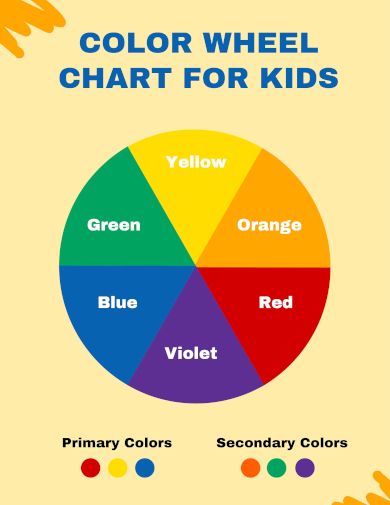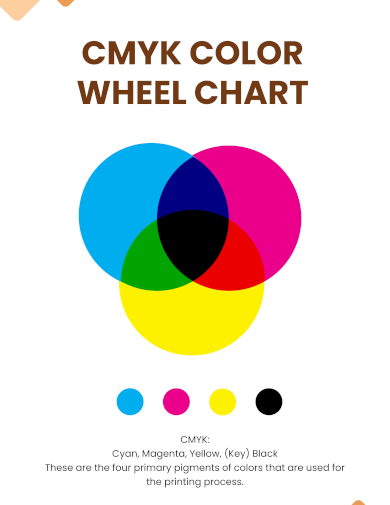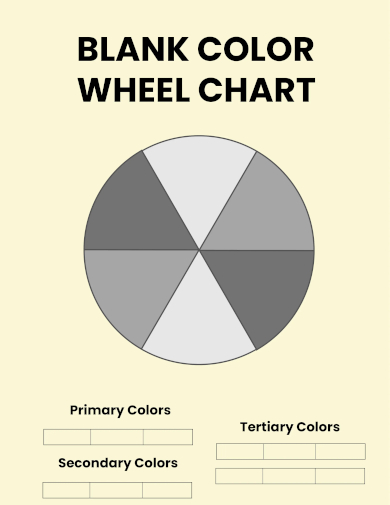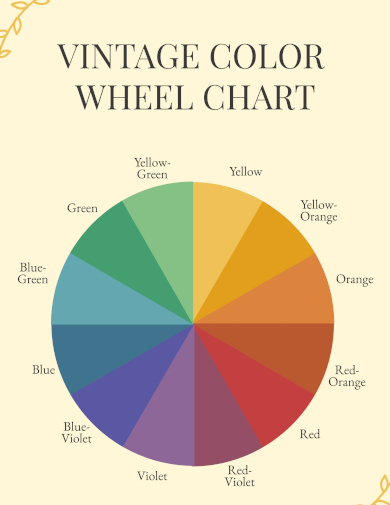The search for the perfect Color Wheel Chart template for your latest booklet, website or presentation ends here. We give you a collection of the best, premium Color Wheel Chart templates that are compatible with MS Word, MS Excel as well as Adobe Photoshop CS+. Color Wheel Chart templates for Clothing and Sherwin Williams color wheel chart is very useful
You can rotate, rearrange and rename the colors as you please before finalizing the design. You can use them on print brochures, as a part of your PowerPoint Presentations, Website Reports to be attached to emails for your clients. They are neat, well defined and can be boldly used for professional purposes. Feel free to check out our complete examples CMYK Color Chart Templates before you finalize your download.
Color Wheel Chart For Kids Template
Color Wheel Chart Template
How To Use Color Wheel Chart?

- Identify the Primary Colors:
- Primary colors are the foundation of the color wheel: red, blue, and yellow. These colors cannot be created by mixing other colors. You can also see more on General Color Chart.
- Understand Secondary Colors:
- Secondary colors are formed by mixing two primary colors. On the color wheel, these are green (blue + yellow), orange (red + yellow), and purple (red + blue).
- Explore Tertiary Colors:
- Tertiary colors are created by mixing a primary color with a neighboring secondary color. Examples include red-orange, yellow-green, and blue-violet. They help to create a more nuanced and rich color palette. You can also see more on RGB Color Chart.
- Learn Color Relationships:
- Complementary Colors: These are opposite each other on the wheel and provide high contrast (e.g., red and green, blue and orange).
- Analogous Colors: These are next to each other on the wheel and create harmonious designs (e.g., blue, blue-green, green).
- Triadic Colors: These are evenly spaced around the wheel and offer vibrant contrast (e.g., red, yellow, blue).
- Apply Color Theory:
- Use the color wheel to create balanced and aesthetically pleasing color schemes. For example:
- Monochromatic Scheme: Uses variations in lightness and saturation of a single color.
- Complementary Scheme: Uses two opposite colors for high contrast.
- Analogous Scheme: Uses three colors next to each other for a harmonious look.
- Triadic Scheme: Uses three evenly spaced colors for vibrant contrast. You can also see more on CSS Color Chart.
- Use the color wheel to create balanced and aesthetically pleasing color schemes. For example:
CMYK Color Wheel Chart Template
Blank Color Wheel Chart Template
Vintage Color Wheel Chart Template
Tips For Creating a Color Wheel Chart
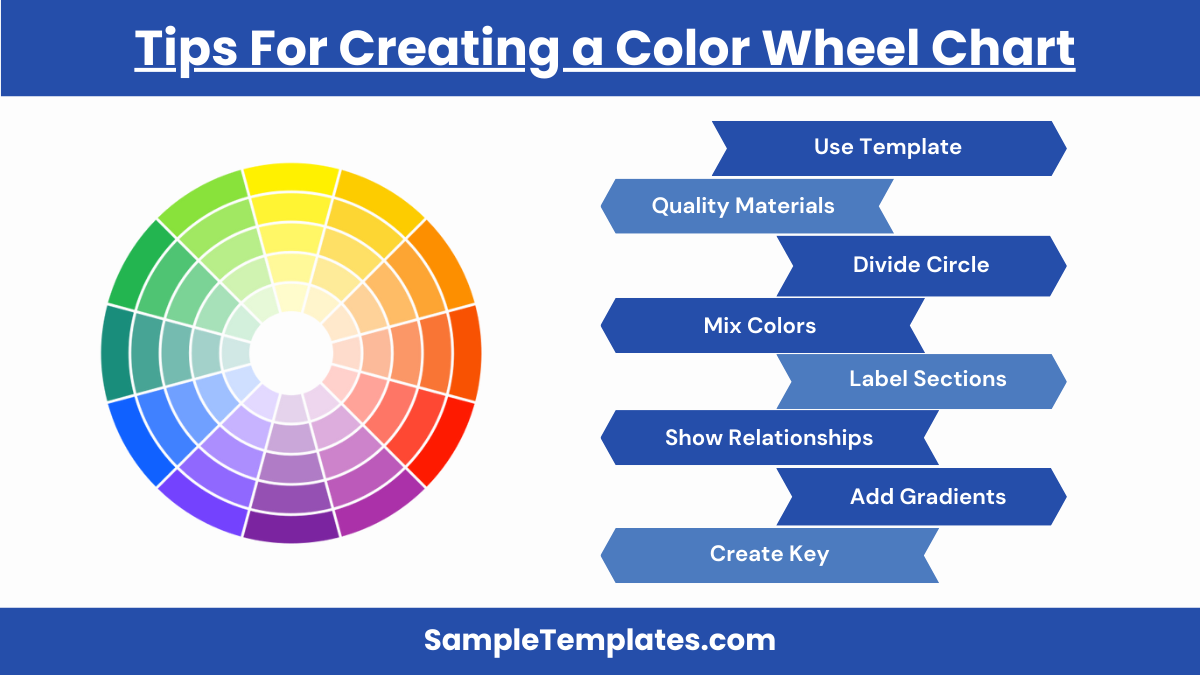
- Start with a Template:
- Use a pre-made color wheel template to ensure accuracy in proportions and placements of colors. Many templates are available online for free. You can also see more on Pantone Color Chart.
- Gather Quality Materials:
- Choose high-quality paints, markers, or digital tools to ensure vibrant and true-to-life colors. Consistency in materials helps maintain color integrity.
- Divide the Circle Evenly:
- Divide your circle into 12 equal sections for a standard color wheel, including primary, secondary, and tertiary colors. You can also see more on PMS Color Charts.
- Accurate Color Mixing:
- Mix colors accurately to achieve the correct hues for secondary and tertiary colors. Start with small amounts and adjust as needed to get the right shade.
- Label Each Section:
- Clearly label each section of the color wheel with the color name (e.g., primary, secondary, tertiary) and the actual color (e.g., red, blue-green).
- Use Gradients for Visual Effect:
- Include gradients to show the range of tints (color + white), tones (color + gray), and shades (color + black). This helps in understanding the color variations.
- Highlight Color Relationships:
- Use lines or arrows to show complementary, analogous, and triadic relationships. This visual aid can help users quickly grasp how colors interact.
- Create a Key or Legend:
- Include a key or legend that explains the different sections and terms used in the color wheel. This can be especially helpful for beginners. You can also see more on Urine Color Chart.
Sample Color Wheel Chart Template
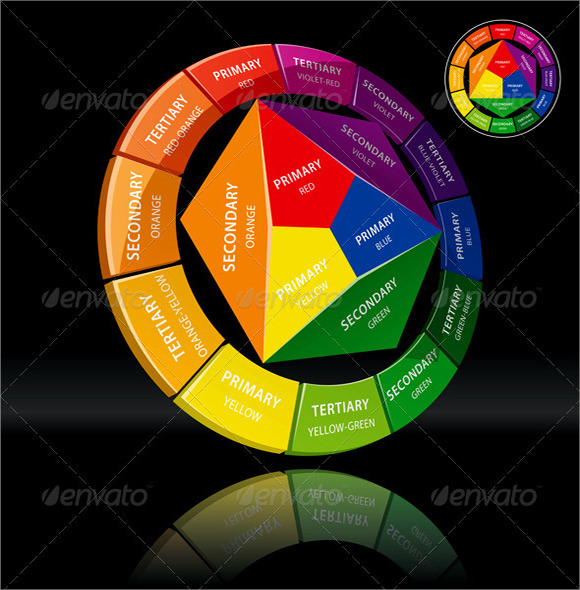
The color wheel chart template consists of a bright three layered color wheel chart. If you wish to rotate it, enlarge it or contract it; this wheel can easily be edited. It is very easy to use and can be used for various professional purpose statement.
Color Wheel Chart Paint Template
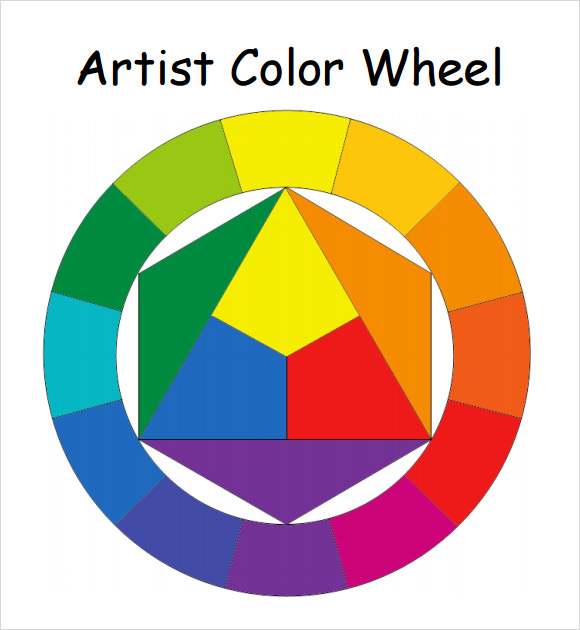
workwithcolor.com
The color wheel chart paint template has the standard color wheel which is very easy to use. This design can easily be used by even kids in their presentations or project analysis. It depicts the primary colors and their combinations.
Basic Color Wheel Chart Template
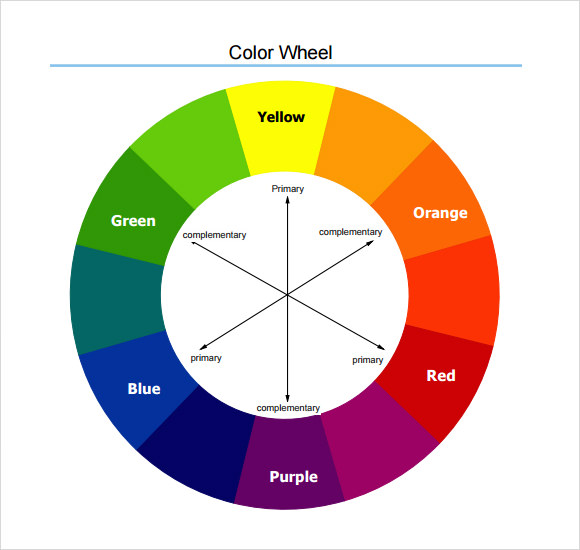
edrawsoft.com
Just as the name suggests, the basic color wheel chart template depicts the basic wheel chart which can be used for multiple purposes. It clearly shows the primary, secondary and tertiary colors. It also depicts the saturation levels between complements.
Sample Color Wheel Chart for Hair Template
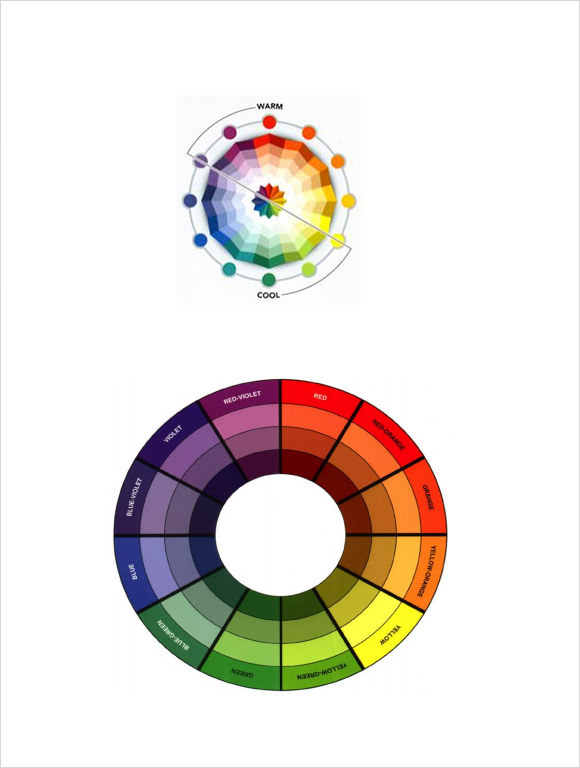
ceuww.com
Interactive Color Wheel Template
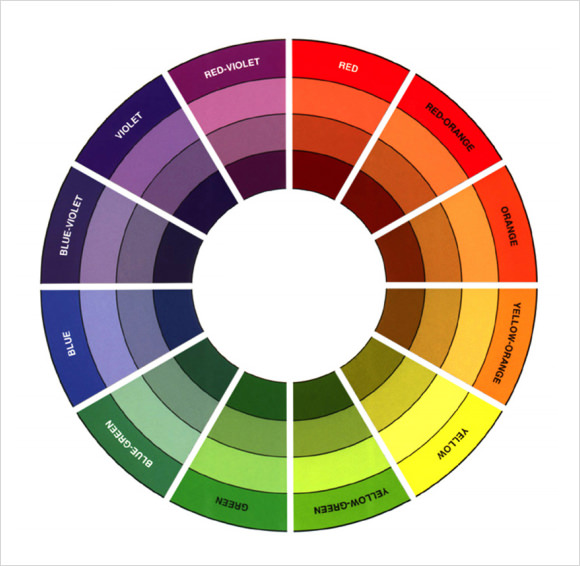
bigbeadlittlebead.com
Printable Color Wheel Chart Template
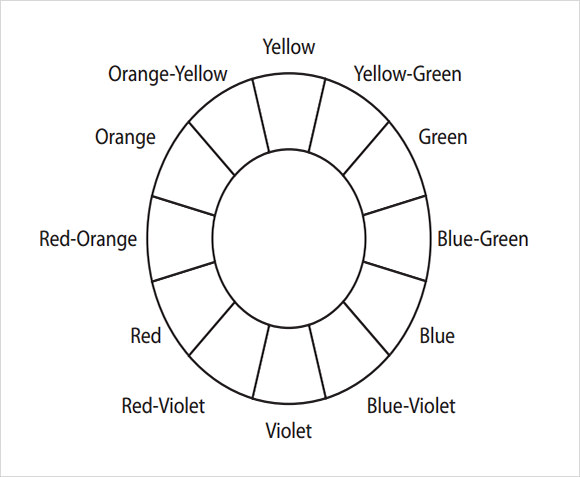
okcareertech.org
Why Does the Color Wheel Chart Template Needed?
The color wheel chart template is needed for understanding the basic color theory. It helps in depicting how the colors are related to each other and which colors falls in which category. With the help of this color chart, one can know which colors complement each other and which colors don’t. It is needed to see what colors we can get by mixing different colors. The knowledge of basic color theory can be useful professionally as well as personally. You can think of different color schemes with the help of these templates. It also provides information about various terms and conditions like warm and cool colors, primary, secondary and tertiary colors, tinted and shaded colors and more.
When Does the Color Wheel Chart Template Needed?
The color wheel chart template is needed to represent the different colors and their relationship with each other in the color wheel. This template is also needed to visually depict the color theory. It is used for showing the relationship between primary colors, secondary colors and tertiary colors. It also highlights the different concepts of colors like the warm and cool colors, complimentary colors and tints and shaded colors. It is very helpful to know different color schemes like which colors can be mixed and used together, which colors do not complement each other and different saturated colors between two colors.
Benefits of the Color Wheel Chart Template
The color wheel chart helps you in determining the colors, mixing them and selecting them according to the purpose. It makes you understand the basic color theory with ease. These templates depict the colors in their correct order. It also states the category in which a particular falls like red, yellow and blue are primary colors. Along with this, it also depicts their relationships with each other which result into the making of secondary and tertiary colors like if blue and yellow colors are mixed, we get the green color which is a secondary color. All this knowledge is very helpful in thinking of various coloring schemes.
The color wheel chart template is easily available on the internet and can be downloaded with equal ease. It is available in a variety of design review to choose the one according to your need and purpose. These templates depict the types of colors and their relationship with each other in a very neat way to make it easy to understand.
How to read a color wheel?
Read a color wheel by identifying primary, secondary, and tertiary colors. Notice complementary colors opposite each other, analogous colors next to each other, and triadic colors evenly spaced. Use it to understand color relationships and harmony. You can also see more on Amazing Circle.
How do I choose a color wheel?
Choose a color wheel based on your needs: basic wheels for beginners, expanded ones for detailed work. Consider wheels with labeled color relationships (complementary, analogous) and gradients for tints, tones, and shades to suit your design or art projects.
What is the concept of the color wheel?
The color wheel is a visual representation of colors arranged in a circle, showing relationships between primary, secondary, and tertiary colors. It helps in understanding color harmony, contrast, and the creation of aesthetically pleasing color schemes.
What is a Colour chart used for?
A color chart is used to reference and select colors, understand color relationships, and create color schemes. It’s a tool for artists, designers, and decorators to ensure accurate color matching and harmonious designs in various projects.
If you have any DMCA issues on this post, please contact us!
Related Posts
Weekly Schedule Samples & Templates
Contractual Agreement Samples & Templates
FREE 9+ Amazing Sample Church Bulletin Templates in PSD | PDF
Sample Business Card Templates
Sample Cashier Job Descriptions
Questionnaire Samples
FREE 10+ Sample HR Resource Templates in PDF
FREE 10+ HR Consulting Business Plan Samples in MS Word | Google Docs | Pages | PDF
FREE 49+ Sample Job Descriptions in PDF | MS Word
FREE 16+ Nonprofit Budget Samples in PDF | MS Word | Excel | Google Docs | Google Sheets | Numbers | Pages
FREE 13+ Academic Calendar Templates in Google Docs | MS Word | Pages | PDF
FREE 10+ How to Create an Executive Summary Samples in Google Docs | MS Word | Pages | PDF
FREE 23+ Sample Event Calendar Templates in PDF | MS Word | Google Docs | Apple Pages
Company Profile Samples
FREE 10+ Leadership Report Samples [ Development, Training, Camp ]
